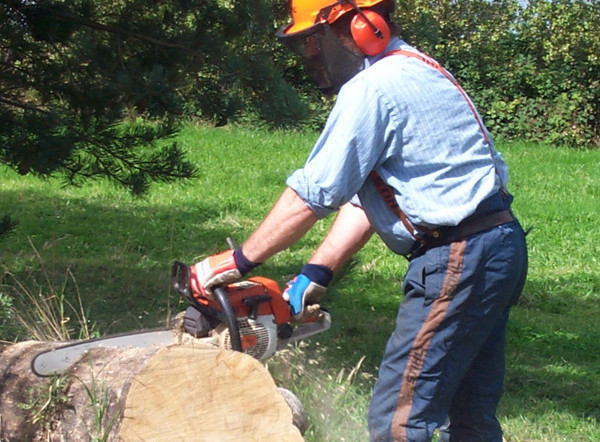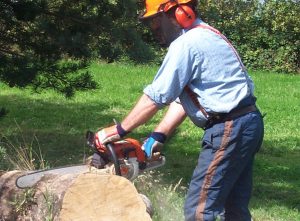“I wanted a chainsaw in pink, but I had to settle for red” – Pam Grier
Contents
What are chainsaws?
A chainsaw is a lightweight, hand-held mechanical saw mostly used for cutting timber – either felling trees or for cutting (cross-cutting – across the grain) logs to lengths that can then be split with a splitting axe for firewood. They have a petrol or electric power source that drives a specialist chain that has a series of cutter links built into it (you don’t find diesel chainsaws – the engine would be too heavy).

A small Stihl petrol chainsaw, ideal for cutting cordwood for firewood on the domestic scale.
With both petrol and electric chainsaws, there’s a lubrication system for the chain. The chain runs around a flat guide bar, and there must be lubrication at all times to prevent excess friction and seizure. Petrol chainsaws need to be fuelled with a petrol / two-stroke oil mix (50:1). Electric chainsaws of course don’t use petrol, but you must use a circuit breaker, as you would do with all externally-used electric tools. Electric chainsaws are quieter, but are limited by the availability of electricity. Petrol chainsaws use a more expensive fuel (petrol), are noisier and smellier, but have the advantage of extreme mobility.
Basic safety and use of a chainsaw to cut logs for firewood – one of the most common uses of a chainsaw.
The safety features can be seen in the diagram below. The chain brake is an internal band brake that can either be manually applied or will self-apply in cases of kickback – this stops the chain instantly. The chain catcher slows the chain down and catches it in cases of derailment or snapping. The safety trigger is a form of ‘dead man’s handle’ (if you let go of the trigger, the chain stops) so it’s essential to have a good grip on the rear handle (to compress the dead man’s handle) before the trigger can be used.
Chainsaws developed from early machines in the mid-20th century that vibrated excessively, and were very noisy and unpleasant to use. However, modern developments in chainsaw technology have reduced pollution and vibration a great deal. Safety features have also been added in an attempt to reduce damage to life and limb.

Chainsaw showing safety features. source: Lantra (click image for larger image)
The chain always runs forwards on the top of the guide bar, and so backwards (towards the user) on the bottom of the guide bar. The most dangerous part of the cutting mechanism is the top quadrant of the bar where the chain starts to go round the nose – this is called the kickback zone. At the kickback zone, the cutter tries to grab too much wood and stops. This causes the whole bar and chain to fly backwards violently towards the operator. So you use the bottom to cut, not the nose (unless you’re extremely skilled).
By the way, there’s no such thing as a left-handed chainsaw, so unfortunately if you’re left-handed, you have to use them as if you’re right-handed.

Delivery of cordwood; an average household will need around 5 tonnes a year to heat their home.
What are the benefits of using chainsaws?
Chainsaws are mobile, fast, easy (if sharp), and able to deal with various shapes. You don’t have to lift material to cut it – you can cut pieces that are too heavy to lift in situ, or cut large pieces into easily-transportable smaller pieces.
There are two alternatives to chainsaws for cutting cordwood (long lengths that need to be cut into pieces short enough to be split with a splitting axe). The first is a benchsaw, run off a tractor. There is an environmental benefit with this option, in that the tractor can be run on biodiesel made from waste oil. But logs can’t be cut in situ – they have to be lifted onto the bench saw.

Personal protective equipment (PPE): helmet with visor and earmuffs, chainsaw gloves, trousers and boots.
The other alternative is the pre-chainsaw option – a two-person cross-cut saw. This is manual, definitely ‘green gym’, and you wouldn’t want to do it for too long – say 20 minutes a day. It’s very hard work, and saws need to be kept in razor-sharp condition. Actually, this option is better for the environment – no fuel, emissions etc – and better for your health, if you’re fit enough, and you have time. Only very few diehards would go back to this system nowadays. But good luck to you if you do.
How to cut through a felled tree using the bore-cutting method, to avoid getting your chainsaw trapped – for City & Guilds chainsaw qualification candidates.
There’s a cost benefit in cutting your own cordwood as opposed to buying your firewood pre-cut and split (ready to burn). However, you need space to store cordwood, and the will to cut and split your own firewood on a regular basis. Prices depend on where in the country you live, but cordwood will have a price per tonne (plus delivery – unless you buy it ‘trackside’ and collect yourself), often delivered in 25 tonne loads. Split firewood is a lot more expensive after the firewood merchant has cut and split it – it could be up to four times the price of cordwood per tonne delivered. However, split firewood is often sold by the cubic metre rather than weight, as seasoned wood is lighter than wet wood). So a chainsaw is worth it financially if you are going to heat your space with wood; and of course you’re going to need one if you have your own woodland, or if you have permission to collect firewood from other woods.

An alternative to a chainsaw for cutting cordwood – a tractor-driven saw bench (guard removed for clarity).
What can I do?
Using a chainsaw can be very dangerous; if you’ve never used one before, it’s like trying to ‘strangle a baby crocodile’ – it wriggles around, and there’s a scary sharp bit at the front. So the first thing to do is get trained. See Lantra or NPTC to find a local accredited instructor. The first course you do will be ‘cross-cut and maintenance’, which includes safe starting, correct use, and maintenance – including sharpening and servicing.
Next you’ll need PPE – that’s personal protective equipment – chainsaw boots, trousers and gloves (this clothing contains chain-clogging fibres so that if you cut into it, it will stop the chain instantly), plus forestry helmet with visor and earmuffs. Accredited PPE will be CE marked – with an image of a chainsaw in a shield.

If cutting the cordwood for firewood, the logs are split on a block, with a splitting axe – fatter than a felling axe.
When you buy a chainsaw, make sure it’s a brand with a good reputation – for example Stihl or Husqvarna. Don’t get a cheap one, as it’s false economy. Get it from a chainsaw dealer, not a DIY chain – that way you’ve got expert back-up if anything goes wrong, and when you need to replace bits from time to time. It also means that your choice of brand will probably depend on the preference of your local dealer. 40-50cc (for the petrol models) and with a bar length of between 12-15 inches (30-40cm) is adequate for the average domestic situation. A cross-cutting / chainsaw horse makes cutting firewood from the length easier, although it’s not absolutely necessary.
Basic servicing of a chainsaw.
You’ll learn about maintenance on a course, but you need to sharpen the chain regularly. If you use a chainsaw all day, for example, you could sharpen it 4 or 5 times. Use the correct sized round file. If the chain is blunt, you’ll use lots of fuel and oil, and put excess strain on you and the chainsaw.
If you want to fell trees, go on courses – if you’ve already done a cross-cut and maintenance course, go on a felling small trees course (up to 15 inch diameter) – see Lantra or NPTC. Once you’ve done this one, there are further courses for larger trees. Or you can get a tree surgeon or competent forester in.

Home-made saw-horse, on which you can saw cords (lengths of timber) to the right length to fit into your wood stove.
If you want to cut your own firewood, you could aspire to keep up to 20 tonnes in stock – 4 years supply for an average house. Then you’ll be sure it’s nice and seasoned.
If you’ve decided you’re going to get one, see our further info section for more information on getting, using & maintaining a chainsaw.
Specialist(s)
Thanks to Andy Reynolds of the Ecolodge for information.
The specialist(s) below will respond to queries on this topic. Please comment in the box at the bottom of the page.
 Andy Reynolds is a carpenter / joiner and woodsman who has tutored courses and authored books with us. He has lived on a smallholding in Lincolnshire since the early 80s, renovated a house, built a holiday cottage and got off-grid. He records his adventures with educational videos on his YouTube channel.
Andy Reynolds is a carpenter / joiner and woodsman who has tutored courses and authored books with us. He has lived on a smallholding in Lincolnshire since the early 80s, renovated a house, built a holiday cottage and got off-grid. He records his adventures with educational videos on his YouTube channel.



1 Comment
Impressive job